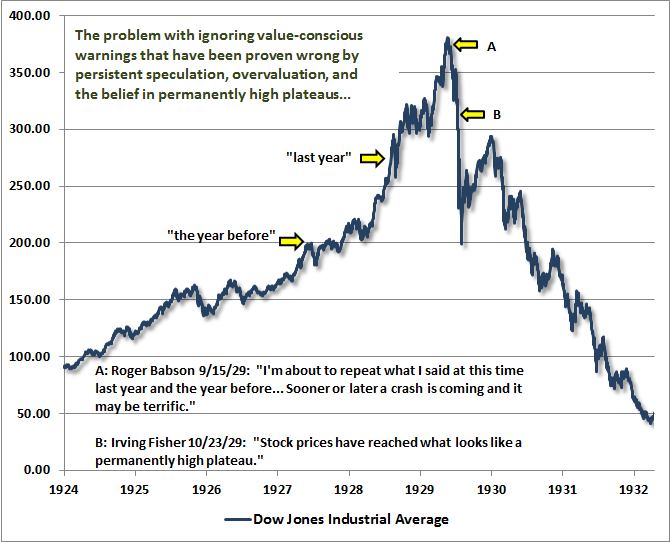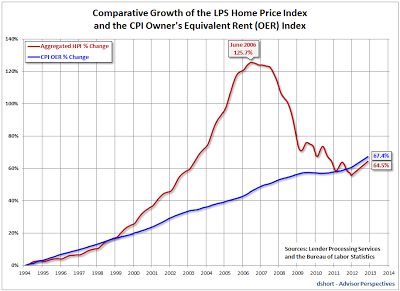Chetan Parikh, of India’s Capital Ideas Online, regularly publishes extracts from investment classics, to educate his readers and clients. In the early 2000s, he selected a 1971 speech by iconic investor David L. Babson. It is eerie how timely this speech, delivered 42 years ago, remains today. The italicized quotes below are from that speech.
I arrived in Wall Street in the spring of 1969, too late to be allowed to join in the late 1960’s fads and bubbles, but early enough to observe how complacency reined. Several well-known economists had proclaimed that the United States had “conquered the economic cycle”, and “Buy on weakness” was a widespread credo as it was believed that any market weakness would never last long. Yet, Parikh reminds us, the market’s postwar Bull Run, which had seen a 400 percent rise in the Dow Jones Industrial Average, came to an abrupt end in 1970. Between January 1 and May 26 of that year, the DJIA lost a third of its value, falling to its lowest level since the beginning of the 1960s. So, in 1971, Babson commented:
Asking the performance investors of the late 1960s what went wrong is like someone in 1720 asking John Law what went wrong with the Mississippi Bubble. Or in 1635 asking Mynheer Vanderveer what went wrong with the Dutch Tulip Craze. Nevertheless, this panel interests me because if we can identify what really did go wrong it may help to avoid a future speculative frenzy. And if we are serious about getting to the bottom of what went wrong then we ought to say what really did go wrong. So let me list a dozen things that people in our field did to set the stage for the greatest bloodbath in 40 years.
First, there was the conglomerate movement and all its fancy rhetoric about synergism and leverage. Its abuses were to the late 1960s what the public utility holding companies were to the late 1920s.
Already then, financial analysts and portfolio managers who had never themselves run a company were urging actual corporate managers to engage into mergers and acquisitions in order to boost reported results through growth synergies and cost savings from the merged entities. Very few of these conglomerations were lastingly successful. Yet, today, a new wave of “activist” investors is arguing for more share buy-backs, increased balance-sheet leverage and other gimmicks intended to give a short-term boost to reported earnings per share.<
Second, too many accountants played footsie with stock-promoting managements by certifying earnings that weren’t earnings at all.
At the time, for example, the then-legal “pooling-of-interest” method of accounting for business combinations allowed companies to acquire a business that had been growing very fast and to restate its own past record as if the two companies had always been merged. This would not boost the combined entity’s current earnings, but it would show the past record (and thus the implied quality of management) in a much better light. Few analysts would order and study five or six years of printed annual reports (no computers, then) to check if originally reported earnings were as good-looking as the “pooled” earnings as restated on the most recent document. I am ashamed to admit that I, too, got fooled once. But I don’t think I made the same mistake again.
Today, if a glamour company seems to show a lot of promise but does not have the level of reported earnings necessary to justify its stock valuation under Generally Accepted Accounting Principles, it simply convinces analysts to use other measures of “operating” earnings, where many expenditures or write-offs are simply not counted.
Third, the “modern” corporate treasurers who looked upon their company pension funds as new-found “profit centers” and pressured their investment advisors into speculating with them.
I am not sure if today’s treasurers are speculating or not with their pension fund assets, but many of them still use actuarial figures assuming that the pension fund portfolio will have an annual investment return of 7%-8%. Obviously, it will be difficult for a balanced portfolio to achieve these targets with interest rates as low as they are and stock market valuations (price/earnings ratios, for example) at levels that historically have not engendered high future returns. The result is that required contributions to the pension funds are understated and reported earnings are thus overstated.
Fourth, the investment advisors who massacred clients’ portfolios because they were trying to make good on the over-promises that they had made to attract the business in the first place.
Promises that will fool naïve, greedy of even fearful investors still proliferate in the advertising sections of the media, with claimed “guarantees” often of a dubious or unattainable nature. The imagination of promoters (including some presumably reputable ones) is inexhaustible, but the younger the investment market, the more alluring and more preposterous the promises generally are. Currently, the new class of Chinese investors may be among the most vulnerable prey to such schemes.
Fifth, the new breed of portfolio managers who churned their customers’ holdings on the specious theory that high “turnover” was a new “secret” leading to outstanding investment performance.
Envy and gambling are two of the biggest investment dangers. Many (maybe most) investors believe that there exist a few people out there, who “know” things and use methods that the general public is not privy to. These people eagerly bought asset-backed securities on the way to the subprime-mortgage crisis, for example, even as many of promoters of these products were privately making fun of the naïve buyers, as subsequently discovered e-mails have documented.
Recently, high-frequency trading, where computer-heavy organizations use algorithms to enter orders fractions of a second before more traditional traders, is again raising the allure of short-term profit seeking. Investors who may be tempted to engage in trading themselves often confuse highly successful investors, who are rare, and successful salespeople, who can make a lot of money fast but usually not for long. It is good to keep in mind the old Wall Street question:
“Where are the customers’ yachts?”
Sixth, the new issue underwriters who brought out the greatest collection of low-grade junky offerings in history – some of which were created solely for the purpose of generating something to sell.
Interestingly, I don’t believe the term “junk bond” had yet been invented when Babson spoke, nor had asset-backed securities been assimilated to higher-grade securities. But we know how all these more recent inventions turned out.
Seventh, the elements of the financial press who promoted into new investment geniuses a group of neophytes who didn’t even have the first requisite for managing other people’s money, namely, a sense of responsibility.
CNBC, which invented the style of presenting business news as if they were football or hockey competitions, was only launched in the 1980s and Bloomberg television followed as recently as 1994. Both all-day channels are voracious consumers of “expert” interviewees, but entertainment comes before information.
Eighth, the security salesmen who peddled the items with the best “stories” or the biggest markups even though such issues were totally unsuited to their customers’ needs.
I find it ironical that this disdain for what is appropriate for customers has further developed in earnest since regulatory agencies have imposed questionnaires defining investment styles (“conservative”; “growth and income”; “aggressive”, etc.). Questionnaires do not make people responsible – or responsive.
Ninth, the sanctimonious partners of major investment houses who wrung their hands over all these shameful happenings while they deployed an army of untrained salesmen to forage among a group of even less informed investors.
My recollection of old-style brokers, among whom I started my career, is that they were true professionals and decent analysts, who really knew a lot about the shares they recommended. Later, the proliferation of products, both pooled like mutual funds and synthetic concoctions full of derivatives, made it almost impossible for brokers to know each product from the inside, so to speak. As a result, it befell to marketing departments to create new products and organize their sale. Research became an assist of marketing and investment banking departments, with a shrinking freedom for sales people to exercise judgment.
Tenth, the mutual fund managers who tried to become millionaires overnight by using every gimmick imaginable to manufacture their own paper performance.
Actually, I believe this manufacturing of performance has become more difficult in recent years – one of the few areas where regulation may have visibly improved transparency. But consultants and asset allocators invented many other measures, often with enough Greek letters and complicated mathematical formulae, to confuse matters for neophytes.
Eleventh, the portfolio managers who collected bonanza “incentive” fees – the “heads I win, tail you lose” kind – which made them fortunes in the bull market but turned the portfolios they managed into disasters in the bear market.
The fashion in recent years of participating fees, where managers share in the realized portfolio gains, was made popular by hedge-fund and private-equity partnerships. It can be extremely profitable for managers that experience a winning streak of five or ten years, since they receive a share of the gains they have realized without putting much of their own capital at risk. On the other hand, it carries some dangerous features for shareholders. If a manager has had a bad investment period, for example, the incentive to accept disproportionate risks to make up for poor prior results must be high. This kind of “double or nothing” temptation is obviously not in the best interest of clients.
Early hedge or private equity funds offered access to special skills, either in research or in types of investments. More recently, many investment funds have adopted the fee structure without offering either special skills or unusual investment opportunities.
Twelfth, the security analysts who forgot about their professional ethics to become “story peddlers” and who let their institutions get taken in by a whole parade of confidence men.
I believe that most analysts are honest people. But the top management of Enron may have said it best when, before being convicted for fraud, they reportedly described financial analysts as glorified stenographers.
Babson concluded:
These are some of the things that “went wrong”. But for those who stuck to their guns, who tried to follow a progressive but realistic approach, who didn’t prostitute their professional responsibilities, who didn’t get seduced by conflicts of interest, who didn’t get suckered into glib “concepts,” nothing much really did go wrong.
As in earlier periods of delusion most investors tried so hard to be “smart” that they lost the “common sense” that pays off in the long run.
François Sicart*
October 12, 2013
*With considerable help from David L. Babson and Chetan Parikh
Author: Francois Sicart





